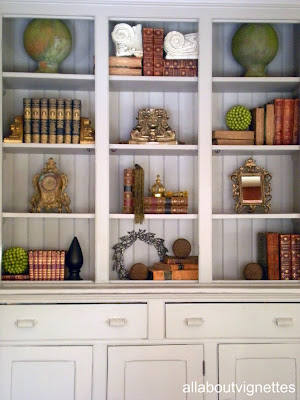I guess you've figured out that one of my favorite things to do is arrange vignettes. I absolutely love combining vintage and new to create a unique look. And, if you've been following me, you know that I change things frequently to the annoyance of my family.
My latest change up is an old step back cupboard in my kitchen. I decided to soften it up by painting the inside the same gray that I used on the outside. The inside was painted a Ralph Lauren red. It seems harsh to me now. Here's my before photo.
It had already been painted so I didn't have to sand first. I did prime it. Since the red was so dark, I used a shellac-based primer called BIN primer by Zinsser. This primer dries in 45 minutes, but if you don't like to clean brushes with chemicals, I suggest you use a small disposable foam roller brush for the big surfaces and a foam paint brush that you can also toss out when you finish. It covered the red in one coat. It took two coats of paint. This is the same paint color I used to paint my kitchen cabinets. (More about the kitchen later.) It's Benjamin Moore Rockport Gray.
I painted the kitchen two years ago and still like the color.
Here's a close up of the items on the shelves.

When styling a bookcase, the first thing I obviously do is assemble the items I want to include. I always select more than I need because not everything will work once you get started. It's important that the items are similar. Books always work and are one of the first things I place on the shelves. They can be used as risers and back drops for other items. An idea to steal is that books don't have to all be upright. If you look at the shelves, some are vertical, some on their sides, and those with interesting uneven pages are facing out.
My books are all either old leather books or ones with marbleized covers. If you're not interested in the hunt, or the expense of vintage books, you can achieve the look a la
Restoration Hardware just by covering the books--just like you do with your school books--with paper.
Notice on the second shelf from the bottom they've placed an old dictionary with the pages facing out. The indentations for the alphabet create an interesting design.
After I place the books, (notice how I interspersed them on the shelves), I begin placing the larger items. On the top shelf are two cement garden orbs. They moved around a bit until they found their place on the top shelf. You need to experiment and move things in different spots,
or if they don't work, take them out of the mix.
Repetition of like items is another consideration. Notice that I selected architectural fragments. They're all different and at the same time blend and serve different purposes.
Some stand alone while others are used as bookends.
Another example of repetition can be seen in the orb shapes. The garden orbs that I already mentioned, the seed balls, and on the bottom shelf the three French orbs that are made with iron nails and weigh a ton.
If you look at them and the rest of the shelves, you'll notice that in addition to similarity of items, you must consider balance and symmetry.
Next I selected interesting items to fill in the other spaces. Notice though that except for the metal laurel wreath on the bottom shelf, they all have gold tones. The old clock, the vintage metal mirror, and even the gold boullion fringe draped over the books repeat the gold. See this repetition of color also in the book spines, the architectural fragment and the crown which is really a Christmas ornament. In addition to the gold, you can see green, which not only repeats, but adds a pop of color.
I hope you'll give it a try. It's a bit time consuming, but if you keep in mind Symmetry, Compatibility, Balance, and Repetition, with some juggling, you can do this.
I'd love to see your results.
To see another post with a totally different look about styling a bookcase, go
here.
















































